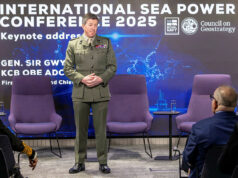Engineers at Lockheed Martin and NASA breathed life into the next Orion crew module when they powered up the spacecraft for the first time at the Kennedy Space Center, Florida.
Designed for human spaceflight, this Orion will be the first to fly more than 40,000 miles beyond the Moon during its nearly three-week Exploration Mission-1 (EM-1), a feat that hasn’t been possible before.
“Orion was designed from the beginning to take humanity farther into space than we’ve ever gone, and to do this, its systems have to be very robust and reliable,” said Mike Hawes, vice president and Orion program manager at Lockheed Martin. “Over the last year, we’ve built great momentum in assembling the crew module for EM-1. Everyone on the team understands how crucial this test campaign is, and more importantly, what this spacecraft and mission means to our country and future human space flight.”
The initial power-on event was the first time the vehicle management computers and the power and data units were installed on the crew module, loaded with flight software and tested. Evaluating these core systems, thought of as the “brain and heart” of the Orion capsule, is the first step in testing all of the crew module subsystems.
According to the defence giant in a statement:
“Although astronauts will not fly in this capsule on this flight, a large majority of the subsystems and avionics are the same design that astronauts will rely on during following missions with Orion into the solar system. Launching on NASA’s Space Launch System—the most powerful rocket in the world—the EM-1 flight is critical to confirming the Orion spacecraft and all of its interdependent systems operate as designed in the unforgiving environment of deep space.
With the successful initial power on behind them, engineers and technicians will now continue integrating the 55 components that make up the spacecraft avionics suite, connecting them with nearly 400 harnesses. Over the course of the next two to three months, as each system is installed, they will perform thorough functional tests to ensure Orion is ready to move to the all-important environmental testing phase.”
NASA’s Orion multi-purpose crew vehicle is the world’s first human-rated spacecraft designed for long-duration, deep space exploration. Orion will transport humans to interplanetary destinations beyond low Earth orbit, including the Moon and eventually Mars.
Lockheed Martin is the prime contractor to NASA for Orion, and is responsible for the design, build, testing, launch processing and mission operations of the spacecraft.














I want to go please!!